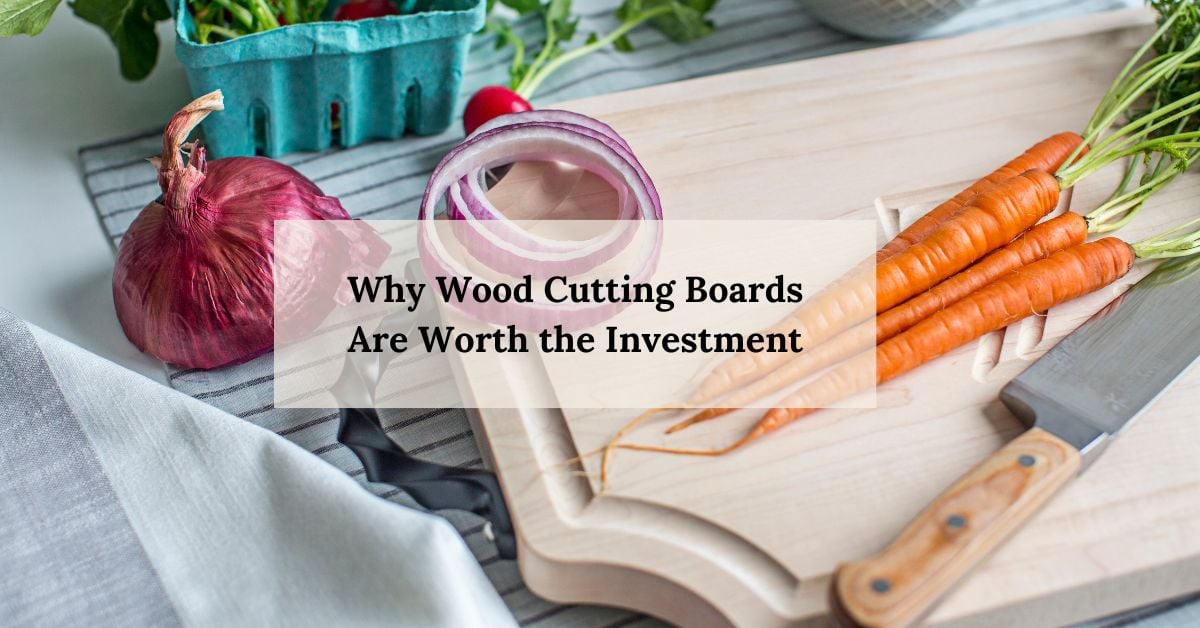Why Wood Cutting Boards Are Worth the Investment (And How to Choose the Right One)

If you’ve been using those thin plastic cutting boards or, heaven forbid, cutting directly on your countertops, switching to a quality wood cutting board will genuinely change your cooking experience. But with so many options out there, it’s worth understanding what makes wood boards special and whether they’re right for your kitchen.
What Makes Wood Different (And Better)
Your Knives Will Thank You Wood cutting boards are naturally self-healing. When your knife cuts into the surface, the wood fibers close back up around the cut. Compare that to plastic boards that develop permanent grooves where bacteria can hide, or glass boards that dull your knives in a hurry.
Natural Antibacterial Properties Quality hardwoods like maple and walnut have natural antimicrobial properties. Studies have shown that bacteria actually die on properly maintained wood surfaces, while they can thrive in the scratches of plastic boards.
They Just Feel Better There’s something satisfying about the solid thunk of a knife hitting wood versus the hollow sound of plastic. Wood boards provide the right amount of resistance – firm enough for stability, soft enough to protect your blade.
Practical Benefits You’ll Actually Notice
Stability During Use A properly weighted wood board doesn’t slide around your counter like lightweight alternatives. This isn’t just convenient – it’s safer. You can focus on your knife work instead of wrestling with a moving target.
Noise Reduction If you’ve ever tried to prep vegetables early in the morning on a glass or stone cutting board, you know how loud that can be. Wood naturally dampens sound, making your kitchen work more pleasant for everyone in the house.
Temperature Friendly Wood doesn’t get shockingly cold in winter or uncomfortably warm when your kitchen heats up. It maintains a comfortable temperature that feels good to work on.
Features That Actually Matter
Double-Sided Use Some boards are designed for use on both sides – one for vegetables, one for meat, or just to extend the life of your board by rotating use.
Thoughtful Edges Slightly raised or shaped edges give you better grip when moving the board, and some designs include subtle angles that make scooping chopped ingredients easier.
Smart Storage Solutions Holes for hanging, grooves for standing upright, or handles for easy transport – these aren’t just convenience features, they’re about making your board accessible enough that you’ll actually use it.
Wood Type Guide
Maple: The All-Around Champion Light colored, extremely durable, gentle on knives. It’s the professional choice because it performs consistently and looks clean even after heavy use.
Walnut: The Elegant Option Rich, dark tones that hide stains well and develop beautiful patina over time. Slightly softer than maple but still plenty durable for home use.
Cherry: The Character Choice Gorgeous color that deepens with age, moderate hardness. Often chosen for its beauty as much as its function.
Sizing Your Board Right
Consider Your Counter Space A board that doesn’t fit comfortably on your counter won’t get used. Measure your workspace and leave room to maneuver around the board.
Think About Storage Where will you keep it? Larger boards look impressive but need proper storage. Smaller boards are easier to handle but limit your workspace.
Match Your Cooking Style If you prep a lot of vegetables at once, bigger is better. If you mostly cook for one or two people, a medium board might be perfect.
The Maintenance Reality Check
It’s Not Complicated, But It’s Not Negligible Wood boards need hand washing (no dishwasher), immediate drying, and monthly oiling with food-safe mineral oil. If that sounds like too much work, stick with plastic.
They Improve with Age Unlike synthetic materials that degrade, a well-maintained wood board gets better over time. Small knife marks add character, and proper oiling deepens the natural color.
When to Replace Deep cracks, warping, or boards that can’t be cleaned properly need replacement. But with proper care, a quality wood board can last decades.
When Wood Boards Make Sense
You’ll Love Wood Boards If:
- You cook regularly and want tools that enhance the experience
- You don’t mind basic maintenance routines
- You appreciate natural materials and their aging process
- You want something that can double as a serving piece
Stick with Alternatives If:
- You want something dishwasher-safe
- You rarely cook and just need basic functionality
- You prefer ultra-low maintenance kitchen tools
- Budget is the primary concern
Beyond Basic Cutting
Serving and Presentation A beautiful wood board transitions seamlessly from prep to presentation. Slice some cheese and crackers, arrange some fruit, or serve bread directly on the same surface you used for preparation.
Kitchen Decor Quality wood boards are beautiful enough to display. Instead of hiding them in cabinets, they can be part of your kitchen’s visual appeal.
The Investment Perspective
Quality wood cutting boards cost more upfront than basic plastic alternatives, but the cost per use over their lifespan is actually quite reasonable. Factor in the improved cooking experience, the ability to serve on them, and their longevity, and they often represent better value than constantly replacing cheaper boards.
Plus, there’s something to be said for cooking with tools you genuinely enjoy using. A beautiful wood cutting board can make even routine meal prep feel more intentional and satisfying.
Ready to upgrade your cutting game? The right wood cutting board isn’t just a tool – it’s a foundation for better cooking and more enjoyable time in the kitchen.